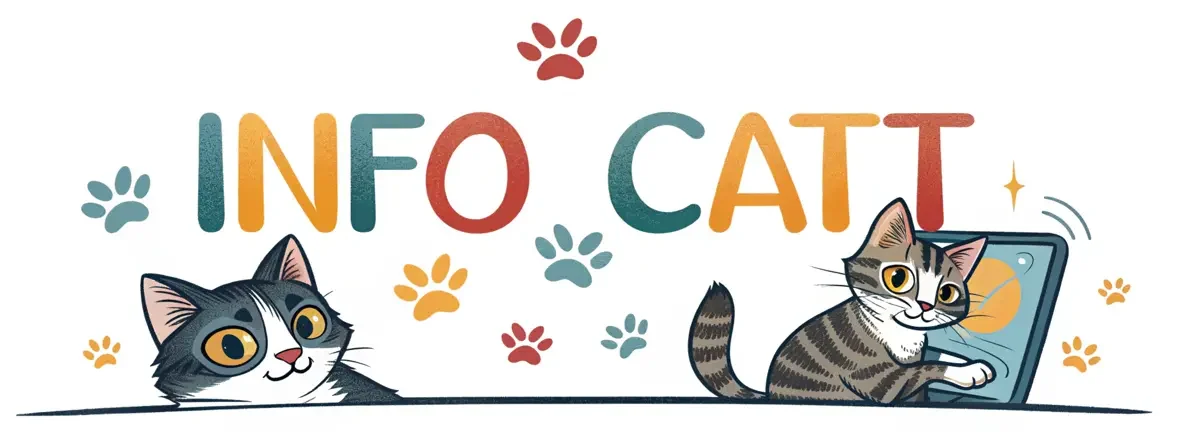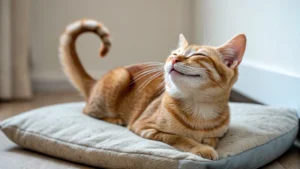Every cat owner has that special moment when their cat looks at them with joy. It’s not just about cute moments. It’s about connecting deeply with your furry friend.
Cats are mysterious and show their feelings in subtle ways. Learning to spot a happy cat can change your relationship. It helps you understand their needs and feelings better than ever before.
By watching your cat’s body language, you open a world of communication. It’s more than just meows and purrs. Cats show happiness in many ways, like tail positions and ear movements.
Understanding Your Cat’s Emotional Expressions
Cats have complex emotional lives that are often hidden. Learning to read their emotions can change how you connect with them. It helps you understand their unique communication ways.
Many think cats are aloof, but science shows they have deep emotional lives. Their behavior and happiness go beyond simple interactions.
The Science Behind Feline Emotions
Cats feel emotions like humans do, thanks to their brain’s limbic system. This system handles feelings like joy and fear. Studies show cats are emotionally smart by:
- Recognizing individual human voices
- Responding to emotional cues
- Demonstrating complex social interactions
Why Cats Hide Their Feelings
Cats hide their emotions to survive. In the wild, showing weakness could attract predators. So, their communication signs are subtle and need careful watching.
The Evolution of Cat Communication
Domesticated cats have developed complex ways to communicate over thousands of years. Their body language, sounds, and facial expressions have become more detailed. This lets them connect well with humans and other animals.
Knowing these communication methods helps you understand your cat’s feelings better. It also strengthens your bond with them.
How To Tell When Your Cat Is Happy Through Body Language
Understanding your cat’s body language opens a new world of communication. Cats show joy through small but clear signs. Learning these signs helps you bond with your pet.
Happy cats show it through their body language. Look for these signs of happiness:
- Relaxed, open posture with a soft, curved body
- Slow, deliberate blinking (often called “cat kisses”)
- Ears positioned in a neutral, forward-facing position
- Tail held high with a slight curve at the tip
Some behaviors also show how cats feel happy. Kneading is a sign of joy, like when kittens feel safe. When your cat comes to you with a raised tail and gently bumps their head, they’re showing love and trust.
“A cat’s body language is a window into their emotional world. Learning to read these signals can transform your relationship.” – Feline Behavior Experts
Facial expressions are key in cat body language. A relaxed face with slightly closed eyes, soft whiskers, and a calm mouth means a happy cat. Watch for these signs to understand your cat’s feelings.
Every cat is different. By watching your cat closely, you’ll learn their special way of communicating.
Decoding Your Cat’s Tail Movements and Positions
Understanding cat tail movements is key for any cat owner. It helps know if your cat loves you. Cats talk a lot through their tails, making it vital for a strong bond.
Your cat’s tail is like a mood ring, showing their feelings. Each position and movement tells a story about their emotions.
Upright Tails: Signs of Happiness and Confidence
When your cat’s tail is straight up with a slight curve, it’s a good sign. This means they’re happy, relaxed, and welcoming.
- Feeling happy and relaxed
- Welcoming your presence
- Displaying trust and comfort
Tail Twitches and Waves: Subtle Communication
Not all tail movements are easy to read. A quick twitch can mean different things:
- Gentle, slow wave: Contentment
- Rapid, aggressive twitch: Potential irritation
- Slight quiver: Excitement or anticipation
Low Tail Positions: Reading Cautionary Signals
A lowered tail might show your cat is unsure or defensive. Paying attention to these signals helps understand their feelings better.
“A cat’s tail is a window to their soul” – Feline Behavior Experts
By learning to read these tail movements, you’ll connect more with your cat. It’s a way to understand their feelings and grow your bond.
Vocal and Physical Signs of Feline Contentment
Understanding your cat’s happiness is more than just watching them. Purring and happiness in cats are closely linked. They show a lot about your cat’s feelings.
Cats show happiness in different ways. Purring is a big sign of a happy cat. When your cat purrs softly while you pet them, it means they’re very happy and comfortable.
- Soft, rhythmic purring during relaxed moments
- Chirping or trilling sounds when greeting you
- Relaxed body posture with muscles uncoiled
Happy cats also show it through their body language. A cat with half-closed eyes, relaxed ears, and a swaying tail is very happy. Kneading behaviors – where your cat pushes its paws against you – also show deep comfort.
“A cat’s purr is like a smile that comes from deep within,” says veterinary behaviorist Dr. Sarah Mitchell.
Grooming is another sign of happiness in cats. When your cat cleans itself or lets you brush its fur, it feels safe and happy. Watch for these small but important signs of joy in your cat.
Conclusion
Learning to know when your cat is happy is more than just watching their actions. It’s about creating a strong bond with your cat. By understanding what makes them happy, you can make their life better.
Understanding your cat’s feelings starts with noticing their body language. Their tail and ears tell you a lot about how they feel. Knowing these signs helps you connect with them better.
Every cat is different, and learning their language takes time. Start by watching how they act every day. This way, you’ll get to know their special signs of happiness. Soon, you’ll understand them better, making your bond stronger.
Understanding your cat’s happiness is a journey that never ends. Keep learning and stay curious about your cat’s world. Your effort will bring you a lifetime of love and trust with your cat.
FAQ
How can I tell if my cat is truly happy?
Look for signs like a relaxed body, slow blinking, and purring. A happy cat also kneads and has a raised tail. They will be calm, have soft features, and enjoy being close to you.
What does a cat’s purr really mean?
Purring shows contentment but can also mean comfort or healing. Cats purr when they feel safe and loved. But, the context matters – it’s different when they’re stressed or in pain.
Why does my cat slow blink at me?
Slow blinking is a sign of trust and affection. It’s like a “cat kiss” that shows they feel safe and comfortable with you. When they blink slowly at you, they’re saying they trust you.
How do cats show love differently than dogs?
Cats show love more subtly than dogs. They love through gentle head-butting, sitting near you, and bringing gifts. Their love is deep but often more reserved.
What does a cat’s tail position mean?
A cat’s tail is a key communication tool. An upright tail with a curve means happiness and confidence. A straight tail with a hook at the end shows friendliness. A tucked tail can mean fear or discomfort.
Can cats show happiness through vocalization?
Yes! Happy cats chirp or trill. These sounds show excitement, greeting, or contentment. If your cat chirps when with you, they’re likely happy and comfortable.
How important is playtime in keeping my cat happy?
Playtime is vital for your cat’s happiness and health. It reduces stress, provides mental stimulation, and strengthens your bond. Happy cats are less anxious and show positive behaviors.
Do cats show happiness through physical contact?
Yes, cats show happiness through physical contact. Kneading, rubbing, sitting on your lap, and seeking pets are signs of happiness. They feel safe, loved, and happy when with you.



